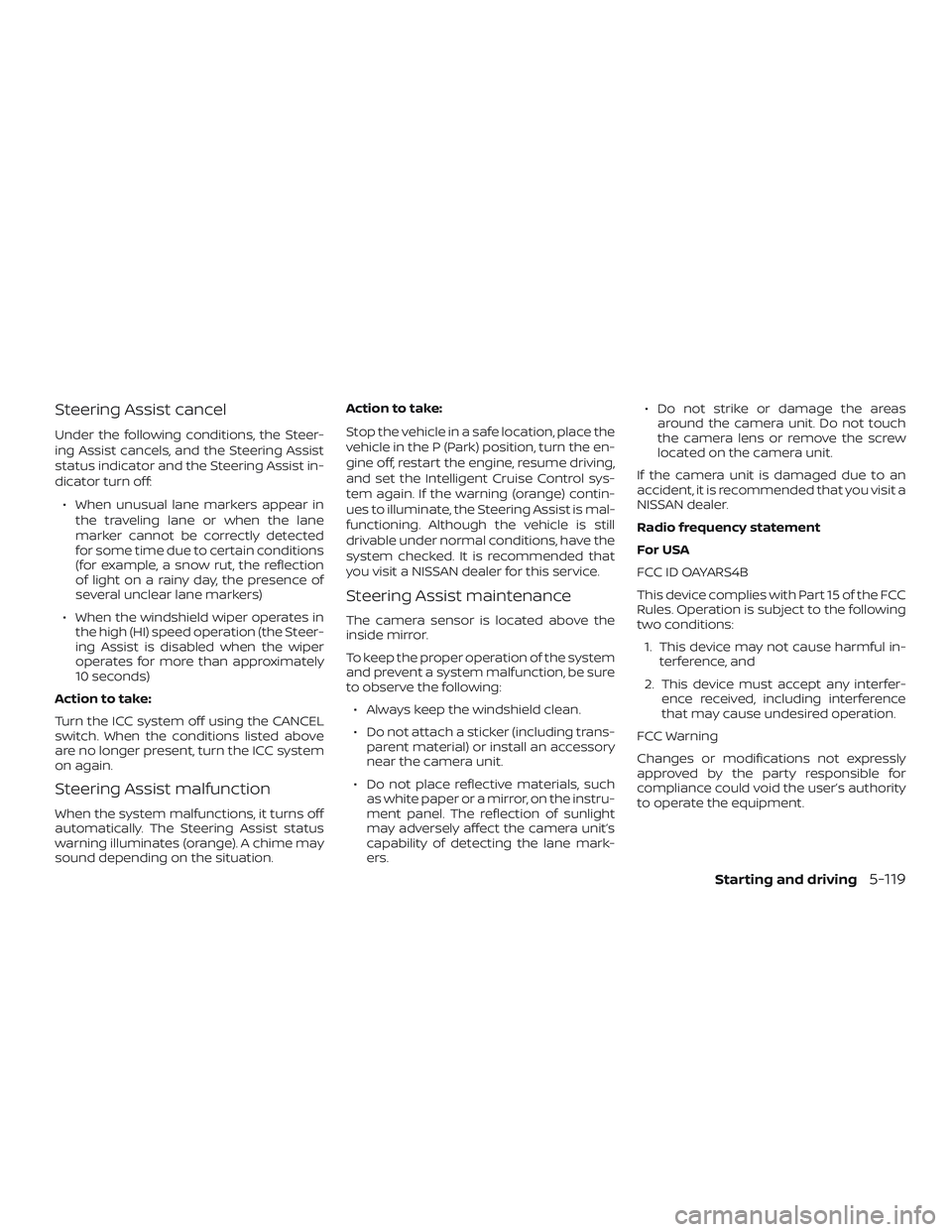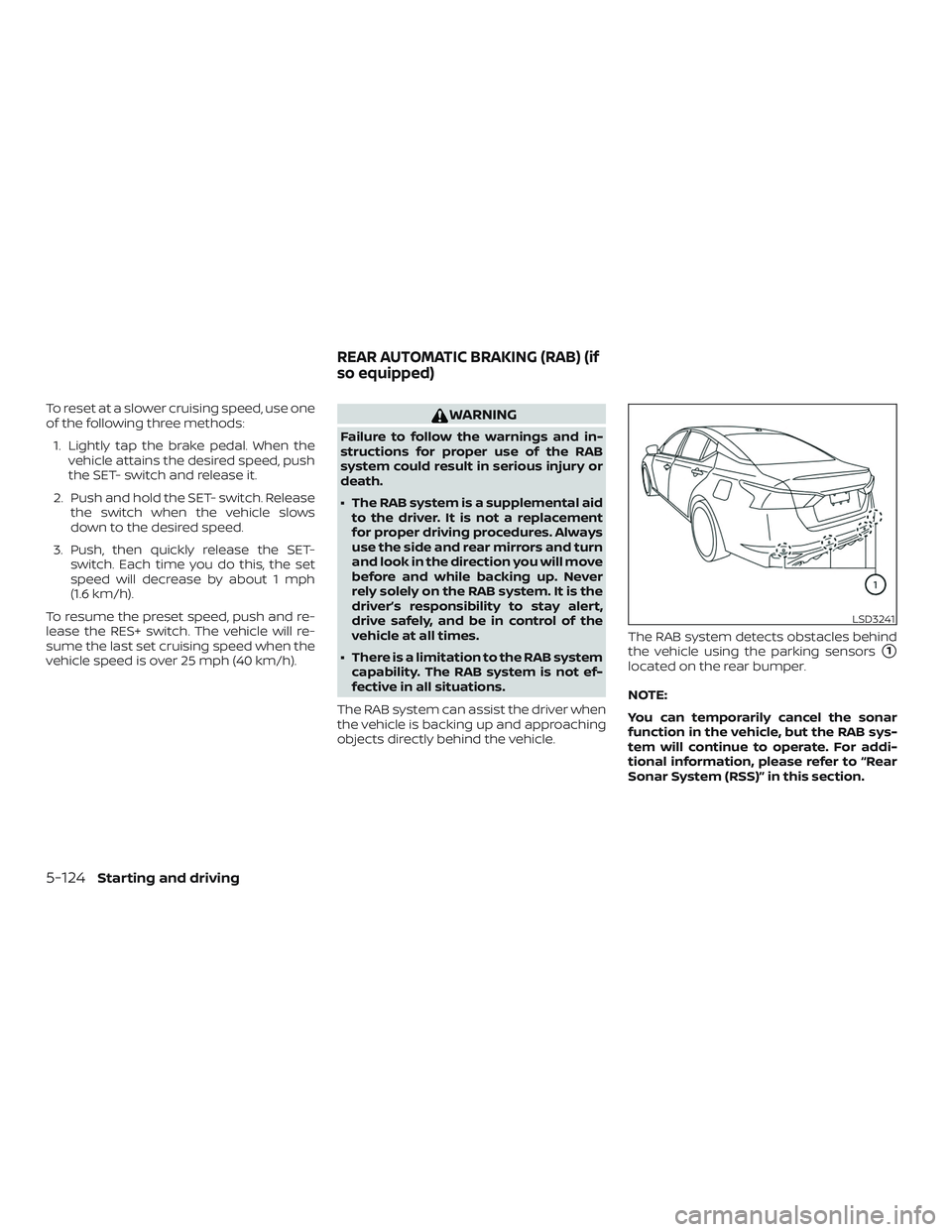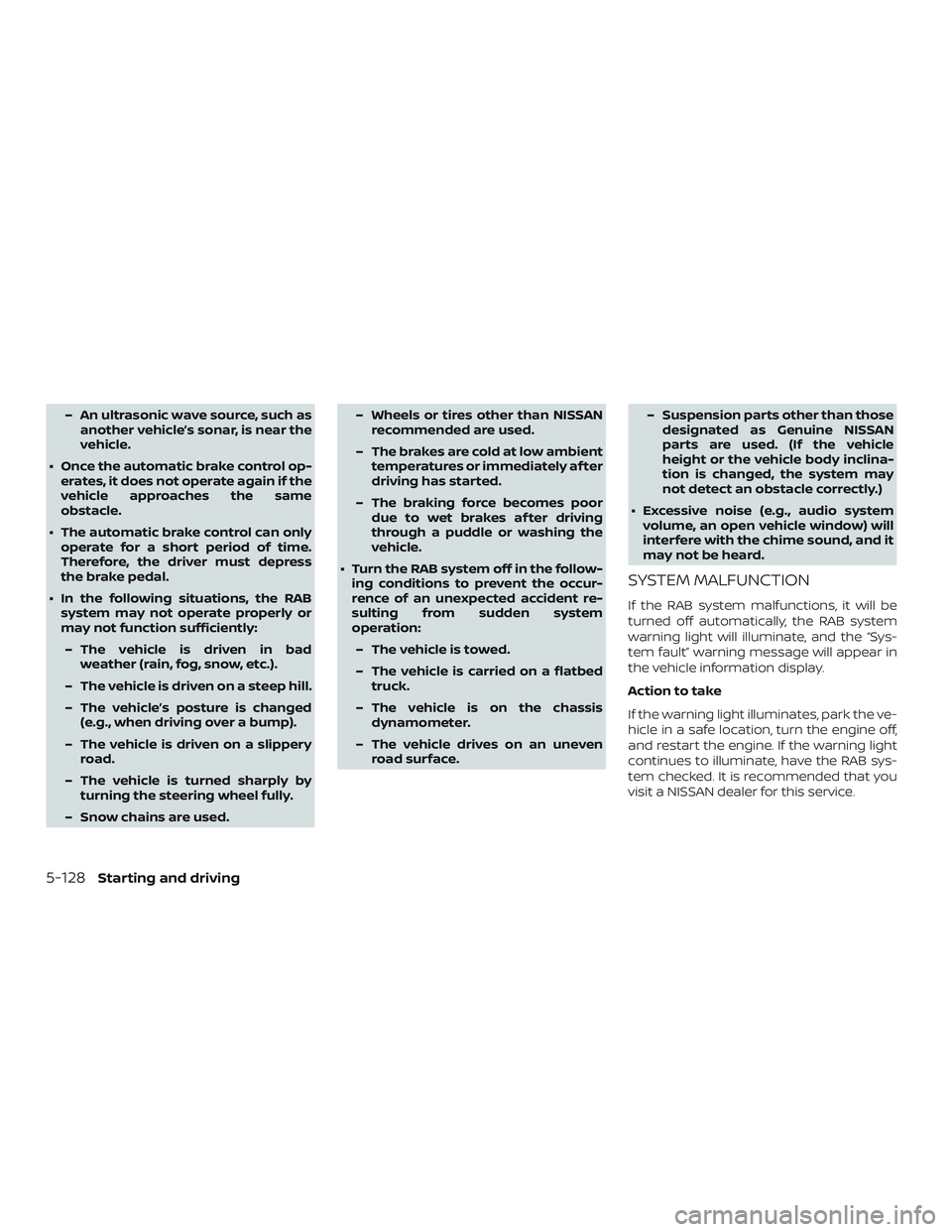Page 366 of 559

Steering Assist cancel
Under the following conditions, the Steer-
ing Assist cancels, and the Steering Assist
status indicator and the Steering Assist in-
dicator turn off:∙ When unusual lane markers appear in the traveling lane or when the lane
marker cannot be correctly detected
for some time due to certain conditions
(for example, a snow rut, the reflection
of light on a rainy day, the presence of
several unclear lane markers)
∙ When the windshield wiper operates in the high (HI) speed operation (the Steer-
ing Assist is disabled when the wiper
operates for more than approximately
10 seconds)
Action to take:
Turn the ICC system off using the CANCEL
switch. When the conditions listed above
are no longer present, turn the ICC system
on again.
Steering Assist malfunction
When the system malfunctions, it turns off
automatically. The Steering Assist status
warning illuminates (orange). A chime may
sound depending on the situation. Action to take:
Stop the vehicle in a safe location, place the
vehicle in the P (Park) position, turn the en-
gine off, restart the engine, resume driving,
and set the Intelligent Cruise Control sys-
tem again. If the warning (orange) contin-
ues to illuminate, the Steering Assist is mal-
functioning. Although the vehicle is still
drivable under normal conditions, have the
system checked. It is recommended that
you visit a NISSAN dealer for this service.
Steering Assist maintenance
The camera sensor is located above the
inside mirror.
To keep the proper operation of the system
and prevent a system malfunction, be sure
to observe the following:
∙ Always keep the windshield clean.
∙ Do not attach a sticker (including trans- parent material) or install an accessory
near the camera unit.
∙ Do not place reflective materials, such as white paper or a mirror, on the instru-
ment panel. The reflection of sunlight
may adversely affect the camera unit’s
capability of detecting the lane mark-
ers. ∙ Do not strike or damage the areas
around the camera unit. Do not touch
the camera lens or remove the screw
located on the camera unit.
If the camera unit is damaged due to an
accident, it is recommended that you visit a
NISSAN dealer.
Radio frequency statement
For USA
FCC ID OAYARS4B
This device complies with Part 15 of the FCC
Rules. Operation is subject to the following
two conditions: 1. This device may not cause harmful in- terference, and
2. This device must accept any interfer- ence received, including interference
that may cause undesired operation.
FCC Warning
Changes or modifications not expressly
approved by the party responsible for
compliance could void the user’s authority
to operate the equipment.
Starting and driving5-119
Page 371 of 559

To reset at a slower cruising speed, use one
of the following three methods:1. Lightly tap the brake pedal. When the vehicle attains the desired speed, push
the SET- switch and release it.
2. Push and hold the SET- switch. Release the switch when the vehicle slows
down to the desired speed.
3. Push, then quickly release the SET- switch. Each time you do this, the set
speed will decrease by about 1 mph
(1.6 km/h).
To resume the preset speed, push and re-
lease the RES+ switch. The vehicle will re-
sume the last set cruising speed when the
vehicle speed is over 25 mph (40 km/h).WARNING
Failure to follow the warnings and in-
structions for proper use of the RAB
system could result in serious injury or
death.
∙ The RAB system is a supplemental aid to the driver. It is not a replacement
for proper driving procedures. Always
use the side and rear mirrors and turn
and look in the direction you will move
before and while backing up. Never
rely solely on the RAB system. It is the
driver’s responsibility to stay alert,
drive safely, and be in control of the
vehicle at all times.
∙ There is a limitation to the RAB system capability. The RAB system is not ef-
fective in all situations.
The RAB system can assist the driver when
the vehicle is backing up and approaching
objects directly behind the vehicle. The RAB system detects obstacles behind
the vehicle using the parking sensors
�1
located on the rear bumper.
NOTE:
You can temporarily cancel the sonar
function in the vehicle, but the RAB sys-
tem will continue to operate. For addi-
tional information, please refer to “Rear
Sonar System (RSS)” in this section.
LSD3241
REAR AUTOMATIC BRAKING (RAB) (if
so equipped)
5-124Starting and driving
Page 372 of 559
�1RAB system warning light and RAB sys-
tem warning indicator
�2Steering-wheel-mounted controls (lef t
side)
�3Center display
RAB SYSTEM OPERATION
When the shif t lever is in the R (Reverse)
position and the vehicle speed is less than
approximately 9 mph (15 km/h), the RAB
system operates.
If a risk of a collision with an obstacle is de-
tected when your vehicle is backing up, the
RAB system warning indicator will flash in
the vehicle information display, a red frame
will appear in the center display (for vehicles
with the Intelligent Around View Monitor sys-
tem), and the system will chime three times.
The system will then automatically apply the
brakes. Af ter the automatic brake applica-
tion, the driver must depress the brake pedal
to maintain brake pressure.
NOTE:
∙ The brake lights of the vehicle come
on when braking is performed by the
RAB system.
∙ When the brakes operate, a noise may
be heard. This is not a malfunction.
LSD3279
Starting and driving5-125
Page 373 of 559
TURNING THE RAB SYSTEM
ON/OFF
Perform the following steps to turn the RAB
system ON or OFF.1. Press the
button until “Settings”
displays in the vehicle information dis-
play. Use the
button to select
“Driver Assistance.” Then press the OK
button.
2. Select “Emergency Brake” and press the OK button.
3. To set the RAB system to on or off, use the OK button to check the box for
“Rear.”
When the RAB system is turned off, the RAB
system warning light illuminates.
NOTE:
The RAB system will be automatically
turned on when the engine is restarted.
LSD3237
5-126Starting and driving
Page 375 of 559

– An ultrasonic wave source, such asanother vehicle’s sonar, is near the
vehicle.
∙ Once the automatic brake control op- erates, it does not operate again if the
vehicle approaches the same
obstacle.
∙ The automatic brake control can only operate for a short period of time.
Therefore, the driver must depress
the brake pedal.
∙ In the following situations, the RAB system may not operate properly or
may not function sufficiently:
– The vehicle is driven in bad weather (rain, fog, snow, etc.).
– The vehicle is driven on a steep hill.
– The vehicle’s posture is changed (e.g., when driving over a bump).
– The vehicle is driven on a slippery road.
– The vehicle is turned sharply by turning the steering wheel fully.
– Snow chains are used. – Wheels or tires other than NISSAN
recommended are used.
– The brakes are cold at low ambient temperatures or immediately af ter
driving has started.
– The braking force becomes poor due to wet brakes af ter driving
through a puddle or washing the
vehicle.
∙ Turn the RAB system off in the follow- ing conditions to prevent the occur-
rence of an unexpected accident re-
sulting from sudden system
operation:
– The vehicle is towed.
– The vehicle is carried on a flatbed truck.
– The vehicle is on the chassis dynamometer.
– The vehicle drives on an uneven road surface. – Suspension parts other than those
designated as Genuine NISSAN
parts are used. (If the vehicle
height or the vehicle body inclina-
tion is changed, the system may
not detect an obstacle correctly.)
∙ Excessive noise (e.g., audio system volume, an open vehicle window) will
interfere with the chime sound, and it
may not be heard.
SYSTEM MALFUNCTION
If the RAB system malfunctions, it will be
turned off automatically, the RAB system
warning light will illuminate, and the “Sys-
tem fault” warning message will appear in
the vehicle information display.
Action to take
If the warning light illuminates, park the ve-
hicle in a safe location, turn the engine off,
and restart the engine. If the warning light
continues to illuminate, have the RAB sys-
tem checked. It is recommended that you
visit a NISSAN dealer for this service.
5-128Starting and driving
Page 376 of 559
NOTE:
If the RAB system cannot be operated
temporarily, the RAB system warning
light blinks.
SYSTEM MAINTENANCE
Observe the following items to ensure
proper operation of the system:∙ Always keep the parking sensors
�1
clean.
∙ If the parking sensors are dirty, wipe them off with a sof t cloth while being
careful to not damage them. ∙ Do not subject the area around the
parking sensors
�1to strong impact.
Also, do not remove or disassemble the
parking sensors. If the parking sensors
and peripheral areas are deformed in
an accident, etc., have the sensors
checked. It is recommended that you
visit a NISSAN dealer for this service.
∙ Do not install any stickers (including transparent stickers) or accessories on
the parking sensors
�1and their sur-
rounding areas. This may cause a mal-
function or improper operation.
LSD3241
Starting and driving5-129
Page 378 of 559
1. Vehicle ahead detection indicator
2. AEB emergency warning indicator
3. AEB system warning light
AEB SYSTEM OPERATION
The AEB system will function when your
vehicle is driven at speeds above approxi-
mately 3 mph (5 km/h).
If a risk of a forward collision is detected,
the AEB system will provide an initial warn-
ing to the driver by both a visual and au-
dible alert.
If the driver applies the brakes quickly and
forcefully af ter the warning, and the AEB
system detects that there is still the possi-
bility of a forward collision, the system will
automatically increase the braking force. If
the driver does not take action, the AEB
system issues the second visual warning
and audible warning and also applies par-
tial braking.
If the risk of a collision becomes imminent,
the AEB system applies harder braking au-
tomatically.
LSD3281
Starting and driving5-131
Page 380 of 559
TURNING THE AEB SYSTEM
ON/OFF
Perform the following steps to turn the AEB
system ON or OFF.1. Press the
button until “Settings”
displays in the vehicle information dis-
play. Use the
button to select
“Driver Assistance.” Then press the OK
button.
2. Select “Emergency Brake” and press the OK button.
3. Select “Front” and press the OK button to turn the system on or off.
When the AEB system is turned off, the AEB
system warning light illuminates.
NOTE:
∙ The AEB system will be automatically
turned on when the engine is re-
started.
∙ The I-FCW system is integrated into
the AEB system There is not a sepa-
rate selection in the vehicle informa-
tion display for the I-FCW system.
When the AEB is turned off, the I-FCW
system is also turned off.
LSD3237
Starting and driving5-133